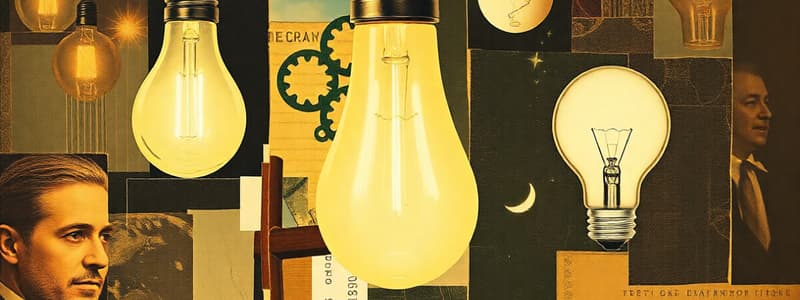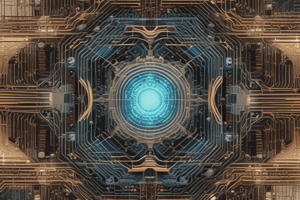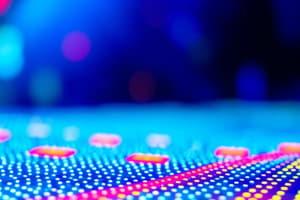Podcast
Questions and Answers
What percentage of electrical energy consumed by incandescent lamps is converted into light?
What percentage of electrical energy consumed by incandescent lamps is converted into light?
- 50 to 60%
- 30 to 40%
- 20 to 30%
- 10 to 12% (correct)
What is the primary advantage of fluorescent lamps over incandescent lamps?
What is the primary advantage of fluorescent lamps over incandescent lamps?
- Fluorescent lamps require more energy to operate.
- Fluorescent lamps have a higher light output efficiency. (correct)
- Fluorescent lamps produce more heat.
- Fluorescent lamps are generally less durable.
How do fluorescent lamps generate light?
How do fluorescent lamps generate light?
- By passing electricity through a glass vacuum.
- By using solar energy collected in the bulb.
- By ionizing mercury vapor and exciting phosphor coatings. (correct)
- By heating a tungsten filament.
What role does the ballast play in a fluorescent lamp?
What role does the ballast play in a fluorescent lamp?
Which of the following is a main goal of green buildings?
Which of the following is a main goal of green buildings?
What type of light do fluorescent lamps primarily produce in the process of generating visible light?
What type of light do fluorescent lamps primarily produce in the process of generating visible light?
What is a common characteristic of incandescent lamps in terms of energy waste?
What is a common characteristic of incandescent lamps in terms of energy waste?
How much less power does a CFL consume compared to an incandescent lamp for the same light output?
How much less power does a CFL consume compared to an incandescent lamp for the same light output?
What is one of the key features of a Green Building regarding energy generation?
What is one of the key features of a Green Building regarding energy generation?
How much less electricity do green buildings consume compared to conventional buildings?
How much less electricity do green buildings consume compared to conventional buildings?
Which of the following is NOT considered a tangible benefit of Green Buildings?
Which of the following is NOT considered a tangible benefit of Green Buildings?
What does wastewater generally include?
What does wastewater generally include?
Which of the following statements about water use in green buildings is true?
Which of the following statements about water use in green buildings is true?
What is a prominent feature of effective waste management in green buildings?
What is a prominent feature of effective waste management in green buildings?
Which of the following elements contributes to indoor environmental quality in green buildings?
Which of the following elements contributes to indoor environmental quality in green buildings?
What is a common misconception about storm runoff?
What is a common misconception about storm runoff?
What is the primary reason Light Emitting Diodes (LEDs) are considered more efficient than conventional light sources?
What is the primary reason Light Emitting Diodes (LEDs) are considered more efficient than conventional light sources?
Which of the following is NOT an application of Light Emitting Diodes (LEDs)?
Which of the following is NOT an application of Light Emitting Diodes (LEDs)?
What constitutes the major components of a compact fluorescent lamp (CFL)?
What constitutes the major components of a compact fluorescent lamp (CFL)?
How does a CFL save energy compared to traditional incandescent bulbs?
How does a CFL save energy compared to traditional incandescent bulbs?
What is the main disadvantage of using Compact Fluorescent Lamps (CFLs)?
What is the main disadvantage of using Compact Fluorescent Lamps (CFLs)?
What is the primary concern addressed by keeping water clean?
What is the primary concern addressed by keeping water clean?
What happens during the process when an LED emits light?
What happens during the process when an LED emits light?
What type of energy transformation is involved in generating electricity from biogas?
What type of energy transformation is involved in generating electricity from biogas?
Which of these statements correctly describes the operating principle of a CFL?
Which of these statements correctly describes the operating principle of a CFL?
Which best describes the role of the AC generator in a biogas plant?
Which best describes the role of the AC generator in a biogas plant?
What characteristic of LEDs makes them favorable for traffic lights?
What characteristic of LEDs makes them favorable for traffic lights?
What is a critical habitat component for aquatic wildlife?
What is a critical habitat component for aquatic wildlife?
What is the main component of biogas?
What is the main component of biogas?
How does a solar cell convert energy?
How does a solar cell convert energy?
Which step is involved in the process after producing electricity from biogas?
Which step is involved in the process after producing electricity from biogas?
Why is clean water vital for wildlife habitats?
Why is clean water vital for wildlife habitats?
What can happen if wastewater is not treated properly?
What can happen if wastewater is not treated properly?
Which pollutant is specifically mentioned as causing oxygen depletion in aquatic environments?
Which pollutant is specifically mentioned as causing oxygen depletion in aquatic environments?
What is a potential result of nutrient overload in water bodies?
What is a potential result of nutrient overload in water bodies?
Which of the following metals is identified as having potential toxic effects in wastewater?
Which of the following metals is identified as having potential toxic effects in wastewater?
What is the primary goal of wastewater treatment?
What is the primary goal of wastewater treatment?
What percentage of suspended solids is typically removed during primary wastewater treatment?
What percentage of suspended solids is typically removed during primary wastewater treatment?
Which pollutant is noted for causing restrictions on beach and shellfish consumption?
Which pollutant is noted for causing restrictions on beach and shellfish consumption?
What does secondary treatment effectively do to suspended solids?
What does secondary treatment effectively do to suspended solids?
Flashcards are hidden until you start studying
Study Notes
Light Emitting Diode (LED)
- Light Emitting Diodes (LEDs) are semiconductor diodes that emit either visible or invisible infrared light when forward biased.
- LEDs combining P-type and N-type semiconductors convert electrical energy directly into light, making them more efficient than conventional light sources.
- Infrared LEDs are used in remote controls.
Compact Fluorescent Lamps (CFLs)
- CFLs are compact versions of fluorescent lamps, providing energy-efficient light generation.
- CFLs use a sealed tube with a phosphor coating and mercury vapor to produce ultraviolet (UV) light, which then excites the phosphor to emit visible light.
- CFLs convert a significantly higher percentage of electrical energy into light compared to incandescent lamps, leading to energy savings and reduced heat generation.
Green Building
- Green buildings are designed, built, and operated in an environmentally sustainable manner.
- They prioritize occupant health, energy and water efficiency, and the use of renewable energy sources.
- Salient features include building envelope design, energy-efficient systems, water recycling, and the use of eco-friendly materials.
Benefits of Green Buildings
- Green buildings consume significantly less energy and water compared to conventional buildings.
- They generate less waste due to on-site waste management strategies.
- Intangible benefits include improved air quality, natural light, occupant health, and a positive impact on the environment.
Waste Water Management
- Wastewater treatment is essential to protect the environment and human health by removing pollutants from used water.
- Wastewater treatment facilities use various methods to remove suspended solids and pollutants, aiming to discharge treated water back to the environment safely.
- Untreated wastewater can harm ecosystems, contaminate drinking water, and affect human health.
Biogas Plant
- Biogas is a renewable energy source derived from the decomposition of organic materials like manure and plant remains.
- Biogas plants use a digester to break down organic matter and generate biogas, primarily methane.
- Biogas is used as a fuel and to produce electricity, offering a sustainable energy alternative.
Solar Cell
- Solar cells are devices that convert light energy directly into electrical energy.
- Semiconductors are commonly used in solar cell material for the conversion process.
Studying That Suits You
Use AI to generate personalized quizzes and flashcards to suit your learning preferences.




